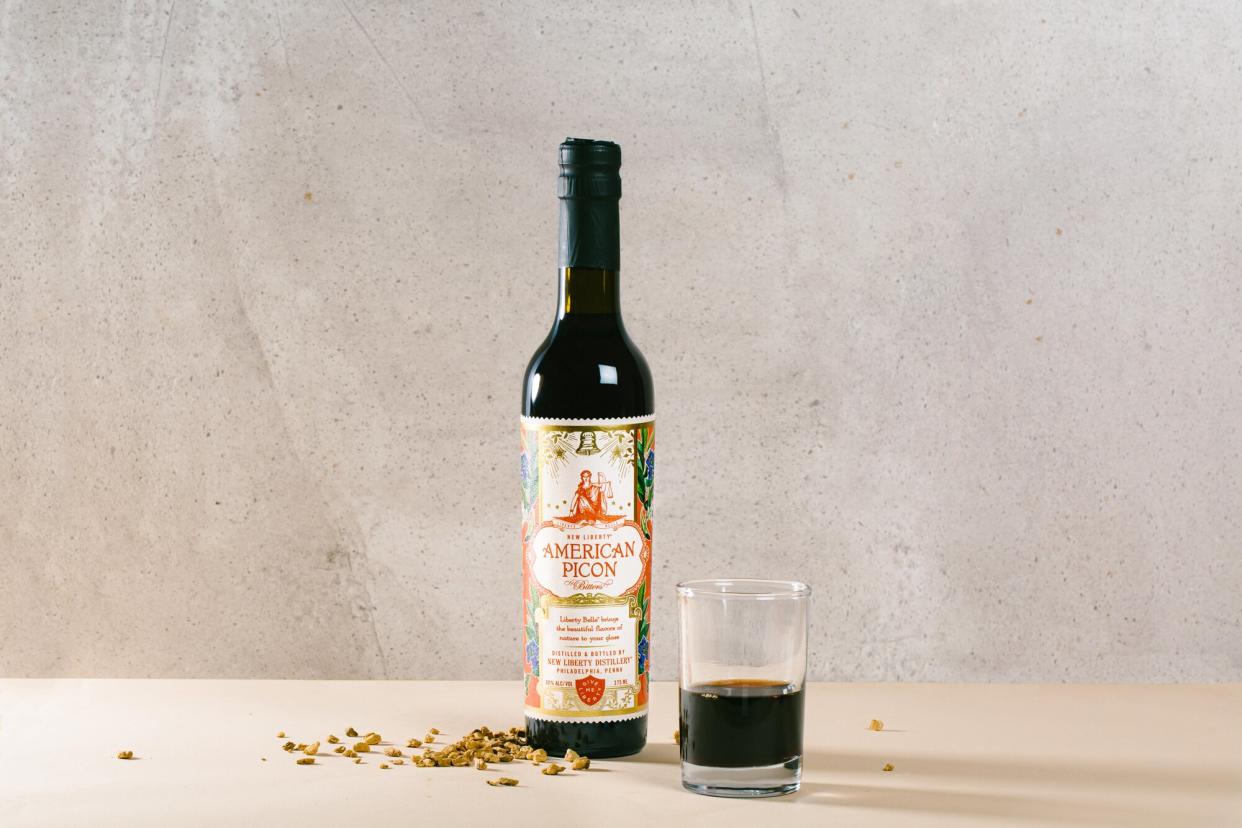This Rare French Aperitif Deserves a Spot on Your Bar Cart

Courtesy of New Liberty Distillery,
It started with a mistake, as good ideas often do.
Robert Cassell was traveling from Paris to meet a Cognac distiller in Beaune, but his miscalculation of the train schedule left him with hours to kill inside Gare du Nord, one of Paris's central train stations. The co-founder of Philadelphia's New Liberty Distillery and the Connacht Whiskey Company in Ireland did what any curious distiller would do: he grabbed a seat in one of the station's cafes, and zeroed in on an unfamiliar menu offering.
"Picon," he remembers thinking. "I have no idea what that is, I don't know how to say it, so I'm gonna order it."
He was served a beer. Or what he thought was a beer. After a few sips and a cursory Google search, Cassell understood what he was drinking. And he was intrigued. "Everybody refers to it as Picon, but it's the modifier of the beer. You're basically just getting this light ale, and you add in the aperitif."
When Cassell finally made it to Beaune and told his French contact about his train station "discovery," the man was unimpressed. "He looked at me blankly and said 'yes?'" Cassell had a moment of self-awareness, decided to stop acting like what he called a "dumb American," and moved on.
But he didn't stop thinking about his train station beer and Picon, a drink one of Cassell's employees called "The Paris citywide" in reference to Philly's iconic shot-and-beer special that originated at beloved dive bar Bob & Barbara's. And years later, he got the chance to make his own version of the French aperitif in the City of Brotherly Love.
RELATED: The French Aperitif to Drink This Summer When You're Over Aperol Spritzes
French distiller Gaétan Picon first created his eponymous aperitif in the early 19th century, using Gentian liqueurs and Quinquina, an aromatized wine made with Cinchona. (The latter contains quinine, which is used to treat Malaria—Picon's own diagnosis was his impetus for first creating the drink.) Though what's now called Amer Picon is a staple in French cafés, it's nearly impossible to procure stateside since it's not exported to the U.S.
Paul MacDonald, head bartender at Philadelphia's Friday Saturday Sunday, says he's only ever gotten his hands on a bootleg bottle here and there. "I haven't worked much with Amer Picon simply because it has never been reliably available in Pennsylvania," he says. But when he gets the occasional order for a Brooklyn cocktail—which calls for Rye, vermouth, maraschino liqueur, and a quarter ounce of Picon—he uses his own blend to approximate the flavor of the French aperitif.
"My favorite way is a fussy mix of Tempus Fugit Gran Classico for bitterness, Ramazzotti for viscosity (and the darker flavors), and Pierre Ferrand Dry Curaçao for orange flavor," he says. McDonald says the hard-to-find spirit is right up his alley, and he may get the chance to stock a local version soon.
After co-founding Philadelphia Distilling in 2004, and working at Victory Brewing before that, Master Distiller Robert Cassell launched New Liberty in 2014. The South Kensington-based distillery specializes in craft whiskey—including bourbon, rye, and Dutch malt, using barley from local Deer Creek Malthouse. But they're also constantly experimenting with new creations, making white rum, liqueurs like sour cherry and Creme de Violette, and a Zinfandel cask-finished whiskey. It was his relationship with Chateau Montelena, a Napa Valley-based vineyard where he procured the casks, that propelled him to make American Picon.
Last summer, when he heard about the wildfires raging through Napa, Cassell checked in on his contact at Chateau Montelena. The staff was safe, but they worried about the damage the smoke would do to their grapes. The vineyard harvested a small amount, which they made into wine, but analytics revealed a trace amount of smoke—not enough to really taste it, but enough that they wouldn't make their usual vintage.
RELATED: Wildfires Destroy Homes and Iconic Wineries in Northern California Wine Country
Cassell told him, "Don't throw it away, I can come up with something to do with it." So they sent him some of the wine, which was essentially unoaked Cabernet.
While the master distiller was brainstorming uses for the potentially smoke-tainted wine, he recalled his train station Picon, thus kicking off the process of making his own. There was a lot of trial and error. "There's not a huge amount of info on what the traditional way was to make Picon," he says.
For Cassell's version, they steep cinchona bark in a distilled spirit for a short time (it can get too bitter quickly, he says.) After straining out the bark, they combine the bitter spirit with the red wine, and that mixture sits for a month or two before it's added to a third mixture—a distilled spirit that's been steeped with bitter orange peels. After testing batch after batch, using different ratios and steeping times, Cassell finally nailed his American Picon. The finished version is orange-forward, bitter with a hint of sweetness thanks to the fruit, and clocking in at about 30 percent ABV. "This is a really interesting aperitif," he says.
Tone Keutzer and Jacob Looney, part of the distillery's team, have created cocktails using their new aperitif, including a classic Picon Punch, made with grenadine and the distillery's apple brandy. They'll sling them from their new patio bar this summer, garnished with sprigs of mint from their on-site garden. The American Picon will also be mixed with a beer from local craft brewery Love City—a French citywide—during a Philly Beer Week event at modern French restaurant Forsythia this June.
Cassell hasn't sent the team at Chateau Montelena a sample of his American Picon yet, but says he will. And he's already thinking about his next concoction. "I'm using the rest of that red wine next year to make an artichoke liqueur."

